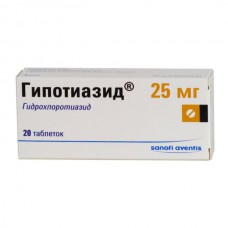Expiration date: 05/2026
Structure and Composition:
Tablets. One tablet contains:
hydrochlorothiazide 25 or 100 mg
Other ingredients: magnesium stearate, talc, gelatin, corn starch, lactose monohydrate
in blister 20 pcs. in a cardboard box 1 blister.
Description pharmaceutical form:
White or almost white round flat tablets engraved "N" on one side and Valium - on another.
Pharmacokinetics:
Hydrochlorothiazide is not complete, but fairly rapidly absorbed from the gastrointestinal tract. This effect persists for 6-12 hours. After oral administration of 100 mg dose Cmax plasma levels achieved over 1.5-2.5 hours.
Diuretic activity at maximum (approximately 4 hours after administration) hydrochlorothiazide plasma concentration of 2 ug / ml. Binding to plasma proteins is 40%. Excreted mainly via the kidneys (filtration and secretion) in unchanged form. T1 / 2 in patients with normal renal function is 6.4 hours, in patients with mild renal insufficiency - 11.5 hours, and for patients with Cl creatinine less than 30 ml / min - 20.7 hours.
Hydrochlorothiazide crosses the placental barrier and is excreted in breast milk.
Description of the pharmacological actions:
The primary mechanism of action of thiazide diuretics increase urine output is by blocking the reabsorption of sodium and chloride ions in early renal tubules. In this way they increase the excretion of sodium and chlorine and hence water. Excretion other electrolytes, namely potassium and magnesium, is also increased.
The maximum therapeutic dose natriuretic / diuretic effect of thiazides are approximately equal. Natriuresis and diuresis occur for 2 hours, reaching its maximum after about 4 hours. They also reduce the activity of carbonic anhydrase by increasing excretion of bicarbonate ion, but this action is weak, and usually does not affect the pH of urine. Hydrochlorothiazide also has antihypertensive properties. In normal blood pressure thiazide diuretics have no effect.
Indications:
- hypertension (used as a monotherapy or in combination with other antihypertensive agents)
- edematous syndrome of different genesis (chronic heart failure, nephrotic syndrome, premenstrual syndrome, acute glomerulonephritis, chronic renal failure, portal hypertension, treatment with corticosteroids)
- control polyuria, preferably at nephrogenic diabetes insipidus
- prevention of stone formation in the urogenital tract in susceptible patients (decrease hypercalciuria).
Contraindications:
- hypersensitivity to the drug or to other sulfonamide
- anuria
- severe kidney (Cl creatinine - less than 30 ml / min) or hepatic impairment
- unmanageable diabetes
Addison's disease:
Refractory hypokalaemia, hyponatraemia, hypercalcaemia
Children under 3 years of age (the solid dosage form).
Be wary of hypokalemia, hyponatremia, hypercalcemia in patients with coronary heart disease, cirrhosis of the liver, gout, in the elderly, in patients with lactose intolerance, while taking cardiac glycosides.
Application of pregnancy and breastfeeding:
Hydrochlorothiazide crosses the placental barrier. Contraindicated use of the drug in the I trimester of pregnancy. In II and III trimester of pregnancy, the drug can be administered only in case of urgent need when the benefit to the mother outweighs the potential risk to the fetus and / or the child. There is a risk of fetal or neonatal jaundice, thrombocytopenia, and other consequences.
The drug enters breast milk therefore, if the use of the drug is absolutely necessary, breast-feeding should be discontinued.
Side effect:
Electrolyte imbalance
Hypokalemia, hypomagnesemia, hypercalcemia and alkalosis gipohloremichesky: dry mouth, thirst, irregular heart rhythm, changes in mood or psyche, cramps and muscle pain, nausea, vomiting, unusual tiredness or weakness. Gipohloremichesky alkalosis may cause hepatic encephalopathy or hepatic coma.
Hyponatremia: confusion, convulsions, lethargy, slowing of thought processes, fatigue, irritability, muscle cramps.
Metabolic effects: hyperglycemia, glycosuria, hyperuricemia with the development of a gout attack. thiazide treatment can decrease glucose tolerance, flowing and latent diabetes mellitus may manifest. At high doses may be increased lipid levels in the serum.
On the part of the digestive tract: cholecystitis, or pancreatitis, cholestatic jaundice, diarrhea, sialadenitis, constipation, anorexia.
Cardio-vascular system: arrhythmia, orthostatic hypotension, vasculitis.
From the nervous system and sensory organs: dizziness, blurred vision (temporary), headache, paresthesia.
From the side of hematopoiesis: rarely - leukopenia, agranulocytosis, thrombocytopenia, hemolytic anemia, aplastic anemia.
hypersensitivity reactions: urticaria, purpura, necrotizing vasculitis, Stevens-Johnson syndrome, respiratory distress (including pneumonitis and non-cardiogenic pulmonary edema), photosensitivity, anaphylactic reactions up to shock.
Other effects: decreased potency, renal dysfunction, interstitial nephritis.
Drug Interactions:
Avoid the simultaneous use of the drug with lithium salts (renal clearance of lithium is reduced, increasing its toxicity).
Be wary of the following medications:
- Antihypertensive drugs (potentiated their action may be necessary to dose adjustment)
- Cardiac glycosides (hypokalemia and hypomagnesemia, coupled with the effect of thiazide diuretics may increase the toxicity of digitalis)
- Amiodarone (its use in conjunction with thiazide diuretics can lead to increased risk of arrhythmias associated with hypokalemia)
- Hypoglycemic agents for oral administration (reduced their effectiveness, hyperglycemia may develop)
- Corticosteroids, calcitonin (increase the level of potassium excretion)
- NSAIDs (may weaken the diuretic and antihypertensive effect of thiazides)
- Non-depolarizing muscle relaxants (their effect can be amplified)
- Amantadine (amantadine hydrochlorothiazide clearance may be reduced, resulting in increased plasma concentrations of amantadine and possible toxicity)
- Colestyramine, which reduces the absorption of hydrochlorothiazide
- Ethanol, barbiturates and narcotic analgesics, which enhance the effects of orthostatic hypotension.
The impact of the drug on laboratory data
Thiazides may decrease the level of iodine in the plasma, bound to proteins.
Prior to the analysis function paraschitovidnh glands thiazides should be abolished. The concentration of serum bilirubin can be increased.
Dosage and administration:
Inside, after a meal.
Dosage should be adjusted individually. With constant medical control sets the minimum effective dose.
Due to the increased loss of potassium and magnesium ions in the treatment process (the serum potassium level may decrease below 3.0 mmol / l), there is a need in the substitution of potassium and magnesium.
Adults. As antihypertensives usual initial daily dose is 25-50 mg once daily, as monotherapy or in combination with other antihypertensive agents. Some patients enough initial dose of 12.5 mg as a monotherapy or in combination. It is necessary to apply the minimum effective dose not exceeding 100 mg / day. If Hypothiazid combined with other antihypertensive drugs, it may be necessary to reduce the dose of another drug in order to prevent an excessive fall in blood pressure.
Hypotensive effect evident within 3-4 days, but may take up to 3-4 weeks to achieve an optimal effect. After treating hypertensive effect lasts for 1 week.
Edematous syndrome of different genesis. The usual starting dose for the treatment of edema is 25-100 mg 1 time per day 1 or 2 times a day. Depending on the clinical response the dose can be reduced to 25-50 mg 1 time per day, or 1 to 2 times of the day. In some severe cases, early treatment can require a dose of 200 mg / day.
When premenstrual syndrome usual dose is 25 mg / day and is used in the period from the onset of symptoms before menstruation.
When nephrogenic diabetes insipidus is recommended usual daily dose of 50-150 mg (in divided doses).
Babies. Doses should be established on the basis of the child's body weight. Usual daily doses pediatric - 1.2 mg / kg or 30-60 mg / m2 of body surface assigned once per day. The total daily dose for children aged 3 to 12 years - 37,5-100 mg.
Overdose:
The most visible manifestation of an overdose of hydrochlorothiazide is acute loss of fluid and electrolytes, which is expressed in the following signs and symptoms:
Cardiovascular: tachycardia, decreased blood pressure, shock.
Neuromuscular: weakness, confusion, dizziness and cramping of the calf muscles, paresthesia, disturbance of consciousness, fatigue.
Gastrointestinal: nausea, vomiting, thirst.
Renal: polyuria, oliguria or anuria (due to hemoconcentration).
Laboratory findings: hypokalemia, hyponatremia, hyposalemia, alkalosis, elevated levels of blood urea nitrogen (especially in patients with renal insufficiency).
Treatment: No specific antidote to an overdose of hydrochlorothiazide is not.
The induction of vomiting, gastric lavage may be ways Withdrawal.
The absorption of the drug can reduce the appointment of activated carbon. In case of decrease in blood pressure or shock should compensate the BCC and electrolytes (potassium, sodium).
It is necessary to monitor the water and electrolyte balance (especially potassium level in serum) and renal function prior to the establishment of normal values.
Special instructions:
In long-term treatment should be carefully monitored clinical symptoms of fluid and electrolyte balance, primarily in high-risk groups of patients: patients with diseases of the cardiovascular system and liver dysfunction in case of severe vomiting or the appearance of signs of violation of water and electrolyte balance as dry mouth, thirst, weakness, lethargy, drowsiness, restlessness, muscle pain or cramps, muscular fatigue, hypotension, oliguria, tachycardia, complaints from the gastrointestinal tract.
Hypokalemia can be avoided by using potassium-containing medications or foods rich in potassium (fruits, vegetables), particularly in the case of enhanced potassium loss (enhanced diuresis, prolonged treatment), or the simultaneous treatment of digitalis glycosides or corticosteroids.
It is shown that increase thiazides magnesium excretion in the urine may lead to hypomagnesemia.
With reduced renal function should be monitored creatinine clearance. Patients with impaired renal function of the drug can cause azotemia and cumulative effects may develop. If renal function is obvious, upon the occurrence of oliguria should consider discontinuation of the drug.
Patients with impaired hepatic function or progressive liver disease, thiazides prescribed with caution because a small change in fluid and electrolyte balance, and ammonium levels in the serum can cause hepatic coma.
In case of severe cerebral and coronary sclerosis drug assignment requires special care.
Treatment with thiazide drugs may interfere with glucose tolerance. During the long course of treatment at the manifest and latent diabetes requires systematic control of carbohydrate metabolism may be necessary to change the dose of hypoglycemic drugs. It requires enhanced monitoring of patients with impaired metabolism of uric acid.
Alcohol, barbiturates, analgesics increase narkotichesike orthostatic hypotensive effect of thiazide diuretics.
When long-term therapy in rare cases observed pathological changes in the parathyroid gland, accompanied by hypercalcemia and hypophosphatemia. Thiazides may decrease the amount of iodine binding to serum proteins, without showing signs of thyroid disorders.
Patients suffering from lactose intolerance, may cause gastrointestinal complaints due to the presence of lactose in the composition of tablets: Tablets containing 25 mg Hypothiazid 63 mg lactose 100 mg Hypothiazid - 39 mg of lactose.
Effects on ability to drive and perform work requiring special attention. In the initial stage of the drug (the duration of this period is determined individually) it is prohibited to drive a car and perform work requiring special attention.



